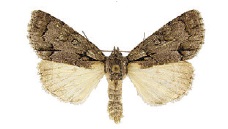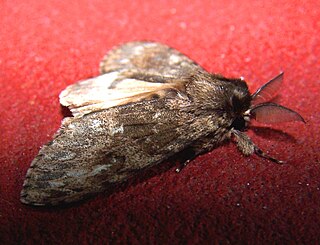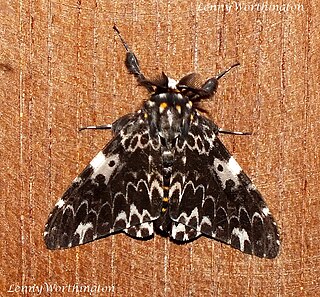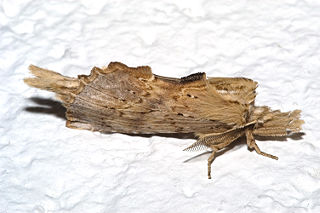
Lymantria dispar, also known as the gypsy moth or the spongy moth, is an Eurasian species of moth in the family Erebidae. Lymantria dispar is subdivided into several subspecies, with subspecies such as L. d. dispar and L. d. japonica being clearly identifiable without ambiguity. Lymantria dispar has been introduced to several continents and is now found in Europe, Africa, Asia, North America and South America. The polyphagous larvae live on a variety of deciduous and coniferous trees and can cause severe damage in years of mass reproduction. Due to these features, Lymantria dispar is listed among the world's 100 worst invasive alien species.

The Lymantriinae are a subfamily of moths of the family Erebidae. The taxon was erected by George Hampson in 1893.

The black arches or nun moth is a small Palaearctic moth. It is considered a forest pest.

Stanwellia grisea, also known as the Melbourne trapdoor spider, is a species of mygalomorph spider in the Pycnothelidae family. It is endemic to Australia. It was described in 1901 by British arachnologist Henry Roughton Hogg.

Lymantria is a genus of tussock moths in the family Erebidae. They are widely distributed throughout Europe, Japan, India, Sri Lanka, Myanmar, Java, and Celebes. The genus was erected by Jacob Hübner in 1819.

Acronicta grisea, the gray dagger, is a moth of the family Noctuidae. The species was first described by Francis Walker in 1856. It is found from the Atlantic to the Pacific coast in southern Canada and the northern United States.
Anonychia is a genus of moths in the family Geometridae described by William Warren in 1893 with type species Anonychia grisea. The genus was described using Nadagara grisea described by Arthur Gardiner Butler and genus Onychia described by Jacob Hübner and two more species added by Frederic Moore i.e. Anonychia lativitta and Anonychia violacea along with his Anonychia rostrifera. The name Anonychia is slightly altered from original Onychia by Hübner and Moore.

Lymantria mathura, the rosy gypsy moth, is a species of moth of the family Erebidae found in the Russian Far East, Nepal, Japan, the Korean Peninsula, northern India and China. The species was first described by Frederic Moore in 1866.

Lymantria brunneiplaga is a species of moth of the family Erebidae first described by Charles Swinhoe in 1903. It is found in Sundaland and the Philippines.
Onoba grisea is a species of minute sea snail, a marine gastropod mollusk or micromollusk in the family Rissoidae.

Lymantria lunata, the luna gypsy moth, is a moth of the family Erebidae. The species was first described by Caspar Stoll in 1782. It is found in Southeast Asia, from India to the northeast coast of Australia.

Lymantria dispar asiatica, the LDA moth or Asian spongy moth, also known as the Asian gypsy moth, is a moth in the family Erebidae of Eurasian origin. It is similar to Lymantria dispar dispar in appearance, but adult females can fly. It is classified as a pest and is host to over 500 species of trees, shrubs and plants.

Lymantria dispar dispar or LDD moth, commonly known as the gypsy moth, European gypsy moth, North American gypsy moth, or spongy moth, is a species of moth in the family Erebidae that is of Eurasian origin. It has a range that extends over Europe, Africa, and North America.

Lymantria serva, the ficus tussock moth or serva tussock moth, is a moth in the family Erebidae. It was described by Johan Christian Fabricius in 1793 and is found in Nepal, Sri Lanka, Assam in India and Yunnan in China. It is possibly also found in Taiwan and Hongkong, but these records might be Lymantria iris.

Eucalyptus grisea, commonly known as grey gum, is a species of tree that is endemic to central Queensland. It has smooth greyish bark, lance-shaped to egg-shaped adult leaves, flower buds in groups of seven, white flower and usually cup-shaped fruit.
Lymantria fuliginosa is a moth of the family Erebidae first described by Frederic Moore in 1883. It is found in Sri Lanka and India.

Lymantria marginata is a moth of the family Erebidae first described by Francis Walker in 1855. It is found in India, Bangladesh, Sri Lanka and Thailand.

Lymantria todara is a moth of the family Erebidae first described by Frederic Moore in 1879. It is found in India (Nilgiri) and Sri Lanka.
Prunus costata is a species of Prunus native to New Guinea. It is a tree reaching 25 m, and is morphologically very similar to Prunus grisea var grisea, aside from their seeds. It flowers are borne on a raceme and have white petals only 1-3 mm long, with 20 to 35 stamens each. The numerous stamens are typically 5.5 mm long, giving the flowers a bristly appearance. P. costata flowers 3 to 4 times per year, and successfully sets fruit after most flowerings. The type specimen was collected on Mt. Scratchley at 10,000 to 13,000 ft (3,000–4,000 m).

Pterostoma is a genus of moths belonging to the family Notodontidae.
















